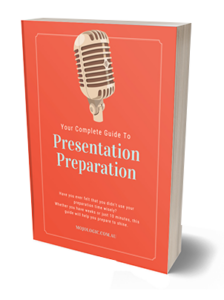How to play with structure in your next speech or presentation
Organising your ideas into a coherent structure can be a challenge.
Great communicators know what works and they reach for tried and true techniques. It is not necessary to make the architecture of your speech obvious to the audience but it almost always exists. A good organising principle helps keep you on track and help the audience to follow along.
The Rule of Three – The King of Structures
Beginning with Aristotle, the advice from communication experts highlights the usefulness of the ‘rule of three’. In fact, if you have done any presentation skills training with us at mojologic, this will sound very familiar to you. People tend to remember things in sets of three. We like the balance.
When you notice it is there, you will see the rule of three at work everywhere – news broadcasts, TED Talks, even a Sunday sermon. We are great advocates of this basic format and we regularly extol the virtues of its usefulness.
I am always gratified at how a little bit of structure, counterintuitively, gives rise to greater creativity. Freedom within boundaries.
Break the Rules
Sometimes you may want to mess with dogma. Not because you don’t respect the time-honoured tradition, but because your topic or audience calls for something completely different.
Maybe you find yourself speaking to the same group over and over again – as a leader, account manager or educator – and you are looking for new patterns of communication. You may want to shake things up a bit. Maybe you are looking to satisfy your own creative urges.
Or, perhaps a new pattern reveals itself to you when you stand back and consider all the content you wish to cover. Don’t let that eureka moment slip away.
Here are some ideas for how you can play with structure in your next presentation.
1. List
Do you have an 8 point plan? Or, 10 things homeowners must do before listing their property? Maybe you would like to share your 21 lessons in leadership. If your content does not fit neatly into 3 buckets, don’t let that dictate your flow. Lists are probably the most simple, but therefore useful, means of organising content.
2. Timeline or Chronology
Will you be speaking about a series of events? Maybe you want to tell the story of ‘the year that was’ or recount the milestones of your career. A chronology-based talk where you lay out major milestones, bringing each to life for your audience, should make an otherwise flat history come to life.
3. Single Story
Perhaps all you want to do in your speech is stand up and tell your story. If you are convinced that this is the right thing for your audience and the best way to make an impact, then go ahead and do it. Let the events of your story be the structure of your speech and make that your focus. (This one is a little bit of a cheat because of course, most stories have a beginning, middle and end – there is that trusty tricolon again)
4. Metaphor or Analogy
‘Our business is like a rally car race. It starts with the mechanics getting the car tuned...’ This can be a great technique to help your audience make sense of otherwise disparate elements of a subject. It also makes the content more memorable and easy to process – assuming you have chosen a metaphor that most people intuitively understand. A word of warning – watch out for overused and tired metaphors, try not to torture them too much or force-fit crucial information.
5. Image/Slide Driven
Just like your report at school ‘What I did on my summer holidays…’ Some topics do better when they are told through imagery, so long as it is relevant. This technique has the added benefit of taking some of the attention away from you. Make sure you talk to your audience, not the screen and give people of few seconds to take in the picture on each slide before you speak.
6. Acronym
Use a word (or phrase) as your structure. Each letter of the word relates to a section of your presentation or talk. I once heard a very touching eulogy where the speaker used each letter of the person’s name to spell out an aspect of their life and share several anecdotes. It was simple, clever and made a lasting impact.
But Remember These Rules…
OK, maybe we do need some rules after all. Or at least guidelines so we don’t end up leaving our audience (and ourselves) even more confused.
Firstly, it is a good idea to make your structure obvious. The audience will be working to assimilate all the information you are going to present. Don’t make them work harder by trying to connect the dots of a pattern that makes sense only to you. Rember, the pattern that you use should help with comprehension and make your presentation more memorable.
Secondly, choose an appropriate pattern. Think about the audience – who are they and what are they expecting? What is their current state of mind and how would you like to shift it?
Finally, be willing to let go. Just because you thought you had a brilliant idea at 3 am doesn’t mean it will continue to work for you in the cold light of day. Kill your darlings. It’s not about your idea or revolutionary structure, it is about your audience and landing your message.
….and there is that ubiquitous rule of three again! Old habits die hard…


